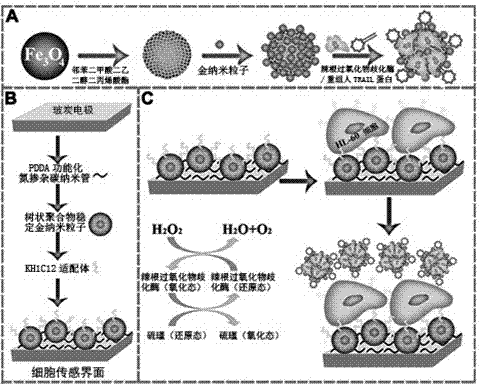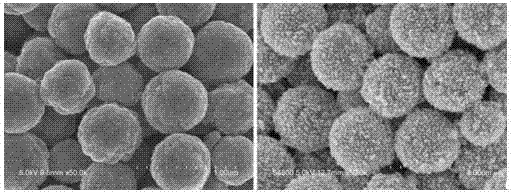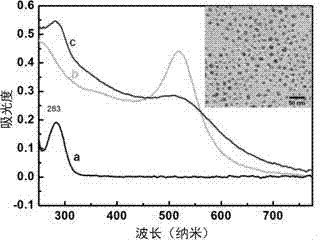Nanometer structure electrochemical cell sensor preparation method, produced nanometer structure electrochemical cell sensor and use thereof
A technology of cell sensors and nanostructures, applied in the direction of material electrochemical variables, etc.
- Summary
- Abstract
- Description
- Claims
- Application Information
AI Technical Summary
Problems solved by technology
Method used
Image
Examples
Embodiment 1
[0035] Example 1. Preparation of multifunctional hybrid nanoprobes for cell sensors
[0036] Weigh 1.35 g of ferric chloride hexahydrate, 3.2 g of anhydrous sodium acetate and 0.5 mL of polyacrylic acid (number average molecular weight: 3000) and add it to 38 mL of ethylene glycol for ultrasonic mixing, then add the mixture into a polytetrafluoroethylene reactor 473 After hydrothermal reaction at K for 6 hours, magnetic separation was carried out, washed several times with ethanol and deionized water respectively, and black magnetic Fe was obtained after drying. 3 o 4 Nanospheres with a particle size of 500 nm ± 20 nm. Take Fe 3 o 4 Disperse 10 mg of nanospheres in 1 mL of deionized water, add 1% PDDA and 1 mL of ultrasonic reaction for 30 minutes, then separate the product under a magnetic field, and wash three times with deionized water to obtain Fe 3 o 4 / PDDA nanocomposite material; gold nanoparticles (Au NPs) were obtained by deoxygenation reaction with tetrachloroal...
Embodiment 2
[0037] Example 2. Assembly of cell-sensing nanoelectrode interface
[0038] Mix 5 mL of tetrachloroalloy acid aqueous solution with a concentration of 4.86 mM and 5 mL of polyamide-amine dendrimer (PAMAM, G=4, provided by Sigma-Aldrich) until the yellow color fades, so that the terminal of PAMAM Amino groups and gold form complex anions. After vigorously stirring the complex with 1.8 mL of reducing agent 20 mM sodium borohydride solution for 30 minutes at room temperature, the color of the solution turns dark red, which is the above-mentioned gold stabilized with dendrimers. Nanoparticles (Au DSNPs) with a particle size of 10 nm ± 2 nm. Glassy carbon electrodes (3 mm in diameter) were mechanically polished with alumina powders with a particle size of 0.3 and 0.05 μm, rinsed with deionized water, and washed with 8 mol L -1 Nitric acid, acetone, and deionized water were ultrasonically cleaned and dried, then 5.0 mg mL was added dropwise -1 Diethylene glycol diacrylate functio...
Embodiment 3
[0039] Example 3. Cell recognition and specificity test of assembled electrode interface
[0040] Drop HL-60 cells and K562 cell suspensions onto the electrode surface treated in Example 1, incubate at 37°C, and observe with a bright-field optical microscope. The results show that 95% of HL-60 cells are captured and maintain their activity , and almost no capture in K562 cells; adding HRP-TRAIL-Fe to HL-60 cell suspension 3 o 4 Au hybrid nanoprobe and Fe 3 o 4 Au nanomaterials were dropped onto the surface of the above-mentioned electrodes, and observed again through a bright-field optical microscope. The results showed that a large number of mixed nanoprobes could successfully immobilize the surface of HL-60 cells. The characterization results are shown in Figure 4 .
PUM
| Property | Measurement | Unit |
|---|---|---|
| diameter | aaaaa | aaaaa |
| diameter | aaaaa | aaaaa |
| particle diameter | aaaaa | aaaaa |
Abstract
Description
Claims
Application Information
 Login to View More
Login to View More - R&D
- Intellectual Property
- Life Sciences
- Materials
- Tech Scout
- Unparalleled Data Quality
- Higher Quality Content
- 60% Fewer Hallucinations
Browse by: Latest US Patents, China's latest patents, Technical Efficacy Thesaurus, Application Domain, Technology Topic, Popular Technical Reports.
© 2025 PatSnap. All rights reserved.Legal|Privacy policy|Modern Slavery Act Transparency Statement|Sitemap|About US| Contact US: help@patsnap.com



